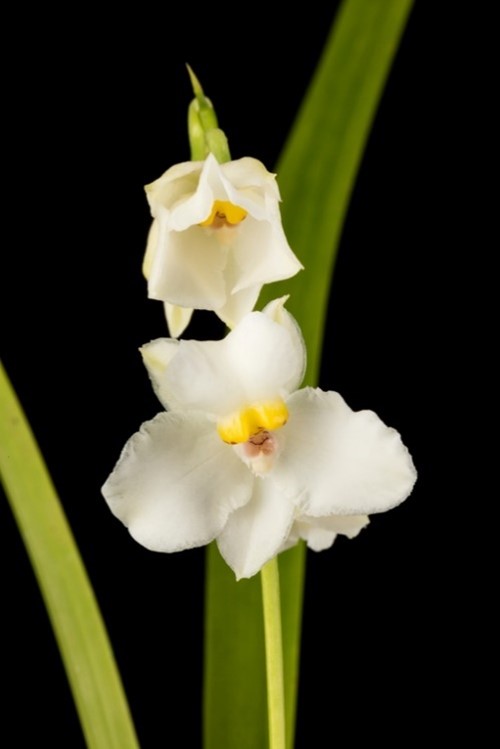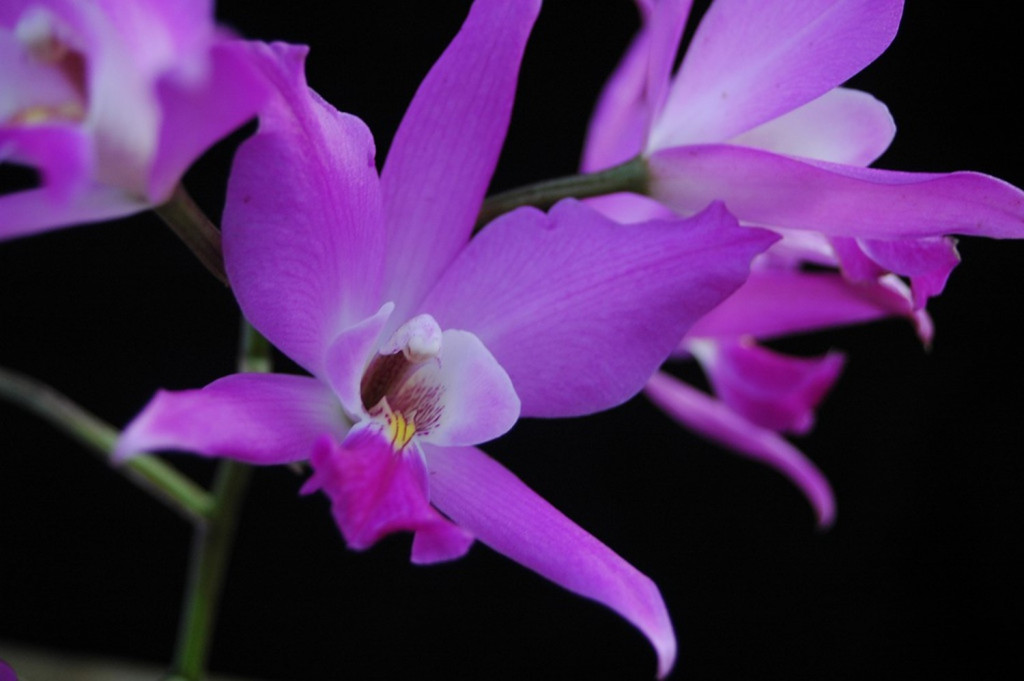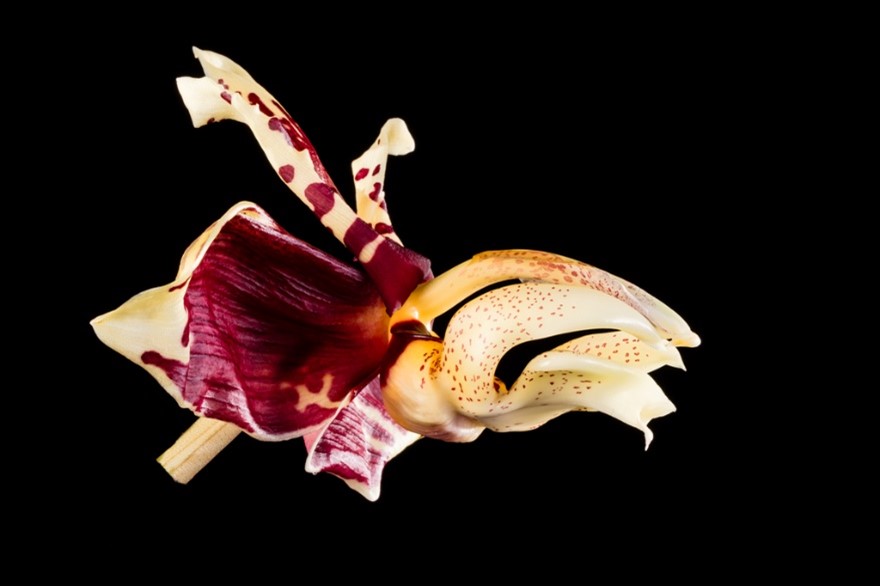The Smithsonian Gardens Orchid Collection Through an Ethnobotanical Lens
In fall 2023, the Smithsonian Gardens Orchid Collection (SGOC) hosted intern Mimi Diaz-Salgado, a recent graduate of Wellesley College, for an 11-week learning opportunity. Mimi’s internship involved both hands-on orchid care and research related to the biocultural connections of orchids in the collection, of which the blog below is a result. SGOC is grateful to Mimi for ensuring indigenous perspectives are represented in collection records.
At the beginning of my internship with the Smithsonian’s Latino Museum Studies Program, all 16 interns participated in an activity that allowed us to individually reflect on ourselves by creating and presenting how we connect to our identities through collaging. My collage was made up of sugar canes, flowers, and volcanoes. It had a veil, representing how even though I had spent my childhood in Mexico, the passage of time had come to blur my memories of my life there. Now, having lived longer in the United States than in Mexico, I tend to question my memories, asking myself if I was remembering my childhood clearly or if I misremembered Mexico. Still, the activity allowed me to better understand how I connect with the Mexico I grew up in with who I am today, noticing that even as a young child, nature has followed me everywhere I am. It’s present in the fruit trees my great-grandmother had in her backyard, where my cousins and I would spend hours jumping up and down with fruit picker poles, always trying to pick the best of the fruits. It’s present now, as I see that my high school, college, and post-undergraduate time is spent surrounded by nature and greenhouses, working with the land, and learning more about orchids.
There may not be much I remember from the Mexico of my youth, but the Mexico of today is one I’m enthusiastically reacquainting myself with.
The connection my family and I have with nature spans back generations and will continue to strengthen. My current work with Smithsonian Gardens has enabled me to combine and bring together my love for plants, culture, and education, encouraging me to research and incorporate my personal experiences in my final project. As a result, this blog is a labor of love, and one I’m excited to share. My time as an intern with the Smithsonian Gardens Orchid Collection has been a well-rounded, intern-centered experience that has encouraged and motivated me to bring my cultural experience into the world of horticulture, supporting me through my process.
Intern Mimi Diaz-Salgado grooming a plant within the Smithsonian Gardens Orchid Collection

Photo by Hannele Lahti.
Through this project, I’ve come to familiarize myself with the world of orchids, learning of its significance around the globe. As it turns out, orchids are vast and diverse, with there being at least 28,000 different species around the world. In Mexico, 1,250 of those species are native to its many states and different climates, spanning from Northern Mexico to Southern Chiapas. Today, I hope to introduce a small part of the Smithsonian Gardens Orchid Collection, sharing both botanical information as well as the cultural stories of these specimens.
Arpophyllum giganteum

Photo by Hannele Lahti.
Found in the Sierra Madre Oriental, the Central Highlands, and the Sierra Madre de Chiapas in the states of Veracruz, Oaxaca and Chiapas, this orchid is well-recognized in the upper and lower parts of the mountain rainforest of Mexico. Known colloquially as the “mazorca gigante,” the Arpophyllum giganteum orchid gets its common name from its flower stems’ resemblance to maize cobs.
Another name this species goes by is “tzauhxilotl.” Of Nahuatl origin, with “xilotl” meaning small cob, “tzauhxilotl” comes from the Nahuatl word “tzaucpopochitl,” with “tzacutli” meaning paste and “popochtli” meaning perfume. The name references its mucilage, a sticky substance obtained from its bulbs. While the mucilaginous substance was obtained especially from Arpophyllum spictacum, it is assumed that both species of Arpophyllums share the substance. The mucilaginous is used to create a paste, referred to as “tzauhtli,” that has been used in the restoration of ancient fabrics of high historical and cultural value.
Cuitlauzina pendula

This plant wasn’t always officially named Cuitlauzina pendula. Although it was first named as such in 1824 by Mexican botanists Pablo de La Llave and Juan Martin Lexarca, English horticulturist James Bateman transferred its genus to Odontoglossum in 1874 at which time it became known as Odontoglossum citrosmumn. The orchid regained its original name in 1975, and this name once again honors Cuitlahuac, brother of Moctezuma and leader of Iztapalapa, a city in Pre-Colombian time and now a borough in Mexico City.
Photo by Hannele Lahti.
Today, the orchid is colloquially known as “orquídea chorritos,” “cola de Borrego,” or “pozolillo.” In the municipality of San Andrés Chicahuaxtla, in the state of Oaxaca, it is distributed in environmentally protected areas in the mountains. Local populations use this orchid for their Semana Santa festivities, as it holds important ceremonial significance for the townspeople. Unfortunately, due to their habitat’s destruction, agricultural practices and excessive logging, their populations have declined a lot.
Laelia speciosa
It was a fun surprise to learn about the great importance the Laelia genus has in Mexico. Not only is this genus native to Mexico, but its use and significance goes back to Pre-Colombian times. Many different Mexican indigenous pueblos have traditionally cultivated species such as L. albida, L. anceps, L. gouldiana, L. autumnales and L. furfuracea, and thanks to the high value attributed to it, the flowers have been used for centuries as part of offerings in the Day of the Dead festivities, hence the common names of some species: “calaverite,” lily of all saints, flower of the dead, and flower of the souls. Other species that flower during different months of the year are associated with other popular festivities such as Mother’s Day, the feast day celebrating the Virgin of Guadalupe, and town patron saint festivities. Laelia wildflowers are sold in markets in various Mexican cities, usually at very low prices.
The Laelia speciosa is considered one of the most beautiful species of the genus and the most widely collected wild orchid in Mexico used for its ornamental and cultural value. The use of this orchid is closely related to other productive and cultural activities. Artisans in several towns in the state of Michoacán extract a mucilaginous substance from its pseudobulbs to make crafts called “figuras de pasta de caña,” or cane paste figures. In Metztitlán, Hidalgo, Laelia speciosa is named “flor de mayo,” and is typically used to adorn the celebration of Mother’s Day, making part of the beautiful arrangements for that holiday as well as decorated yuntas seen during the festival of Saint Isidro Labrador, patron saint of farmers. The term yuntas means ‘together’ but can be translated as well to ‘yokes.’ The festival includes the presentation of yoked oxen by different farmers in the area who re-enact their plowing of arid furrows on the land. The yokes are beautifully decorated with flowers, baskets with fruits and vegetables, breads and drinks, and are blessed so that there is good work in the field and a good storm.
Laelia x gouldiana ‘Nasser’s Andrea‘

Photo by Hannele Lahti.
Primarily associated with the region of Metztitlán, Hidalgo, Laelia gouldiana is known as “monjitas” or “flor de muertos” among the locals. Appreciated by local farmers who use the flower to decorate tombs during the Day of the Dead festivities–hence its colloquial name–these orchids are now more commonly cultivated in the backyards of local residents, as the species is now considered extinct in nature. We have these people to thank for keeping it in a semi-cultivation condition, allowing it to survive and reach other private collections and botanical institutions such as Smithsonian Gardens.
Stanhopea tigrina

Photo by Hannele Lahti.
The Stanhopea tigrina is a rare orchid that grows in the tropical forests of the Sierra Madre Oriental, and it’s one of the most beautiful orchids in Mexico. In Veracruz, this orchid is known as “torito negro” and “vaquita,” while in other areas it’s best known as “cabeza de vibora.” In fact, in Pre-Hispanic Mexico, the orchid carried the Nahuatl name coatzontecomaxochitl, today meaning “serpent-headed flower.” Stanhopea tigrina is distinguished by its ornamental form and the pleasant aroma it emits.
While beautifully ornamental, Stanhopea tigrina was also historically used to treat sunstroke and weakness. The flowers were also incorporated into nixtamal (corn treated with lime to make tortillas) to give the tortillas their unique aroma.
Herbarium Orchids
The orchids I’ve highlighted show a small part of Mexico’s vibrant cultural and environmental diversity. Having these orchids included in Smithsonian Gardens’ Living Collection is a great honor and responsibility for the museum, as they help preserve past and current history of the lands where they originated. So far, I’ve talked about orchids that Smithsonian Gardens has in its collection. I’d like to highlight two more from the Smithsonian’s Herbarium collection that can be found online.
During my internship, I had the privilege to visit and learn about the Smithsonian’s National Museum of Natural History’s Botany Department. There, I was introduced to the United States National Herbarium that currently holds 5 million specimens. Herbarium specimens are preserved samples of plants–usually dried, pressed, and mounted on paper—that are collected with the goal of using the samples and their data for long-term study. Herbaria give histological and geographical information about different plant species, complementing the modern-day plants present in a living collection. After browsing through this collection, I came to find two amazing orchid specimens that hold great significance to their local Mexican populations.
Laelia autumnalis
The species Laelia autumnalis is used in the states of Michoacán, Morelos, and Veracruz to decorate the offerings and tombs on the night of the Day of the Dead. Its common name “calaverita” refers to the appearance of a skull in the center of the flower, with its purple flowers alluding to the act of mourning.
In the city of Apaseo el Alto, Guanajuato Laelia autumnalis is primarily grown in backyard gardens. This variety is used as an ornament, with the mucilage from its pseudobulbs utilized to produce decorations for religious celebrations.
Bletia campanulata
Collected in 1927 from the states of Chiapas, Bletia campanulata is colloquially known as “flor de muertos,” and is one of the orchids used to make the traditional “tzauhtli” glue paste along with Arpophyllum spictacum and Laelia speciosa.
In addition to its service in making “tzauhtli,” Bletia campanulata has a vital role in the traditional making of “dulce de alfeñique,” which today in Mexico is well recognized through the sugar skulls used in Day of the Dead celebrations. Alfeñique was a typical sweet of Islamic Spain, known in Arabic as “Al-Fanid.” Now its main production centers are the cities of Toluca in the state of Mexico and San Miguel de Allende in Guanajuato. Today, the process for making “dulce de alfeñique” has changed. The tradition, which dates back more than 400 years in Toluca, has undergone a modern modification, replacing the only ingredient of pre-Hispanic origin with an industrialized one. Historically, the traditional recipe included four ingredients: powdered sugar, egg white, lemon and chautle. Chautle is a sticky mucilage from the Bletia campanulata orchid that was used for kneading. Academics assure us that collecting Bletia campanulata to use as an ingredient is no longer profitable, since it doesn’t grow in large quantities. Currently, some craftsmen use different ingredients to facilitate and reduce ingredient costs, especially since chautle hasn’t been found in local markets for years like it once was.
Conclusions
All in all, my time with the Smithsonian Gardens has led me down a path I’d never ventured before. In fact, through this internship I came to learn of “ethnobotany,” a term and area of study that was new to me. My journey in researching and putting together this blog didn’t come without its challenges, as the widely circulated knowledge I found regarding these six Mexican orchid species dealt primarily with botanical-based information. Once I noticed this trend, I began expanding my research to include non-traditional resources. I browsed through blogs, social media posts, and YouTube videos, before deciding to conduct all my research in Spanish.

